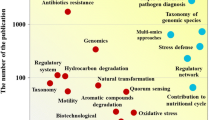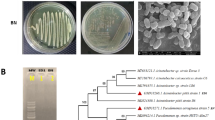Abstract
In an attempt to obtain bacteria growing on 1,2-dimethylbenzene as sole carbon and energy source two different strains were isolated. One was identified as an Arthrobacter strain, the other as a Corynebacterium strain. Corynebacterium strain C125 was further investigated. The organism was not capable to grow on 1,3- and 1,4-dimethylbenzene. cis-1,2-Dihydroxycyclohexa-3,5-diene oxidoreductase and 3,4-dimethylcatechol-2,3-dioxygenase activity was found in cell extracts. When 3,4-dimethylcatechol was added to cell extract of 1,2-dimethylbenzene-grown cells, first a compound with the spectral properties of 2-hydroxy-5-methyl-6-oxo-2,4-heptadienoate was formed and subsequently acetate was produced. It is proposed that dioxygenases are involved in the initial steps of 1,2-dimethylbenzene degradation, and ring opening proceeds via meta-cleavage.
Similar content being viewed by others
References
Adamse, A. D. (1980) New isolation of Clostridium aceticum (Wieringa). Antonie van Leeuwenhoek 46: 523–531
Axcell, B. C. & P. J.Geary (1973) The metabolism of benzene by bacteria. Biochem. J. 136: 927–934
Baker, W., H. F. Bondy, J. Gunb & D. Miles. (1953). 3:4, 3:5, 3:6 Dimethylcatechol. J. Chem. Soc. 1615–1619
Barbieri, P., G. Bestetti, G. Dehò & E. Galli (1986) Biochemical and genetic analysis of 1,2,4-trimethylbenzene and o-xylene catabolism in Pseudomonas strains. In: EMBO Workshop on Genetic Manipulation of Pseudomonads-Applications in Biotechnology and Medicine. University of Geneva, August 31–September 4 1986, Geneva
Bayly, R. C., S.Dagley & D. T.Gibson (1966) The metabolism of cresols by species of Pseudomonas. Biochem. J. 101: 293–301.
Cummins, C. S., R. A.Lelliott & M.Rogosa (1974) Genus I. Corynebacterium. In: R. E.Buchanan & N. E.Gibbons (Eds) Bergey's Manual of Determinative Bacteriology (pp. 602–617) 8th edn. The Williams & Wilkins Co., Baltimore
Davey, J. F. & D. T.Gibson (1974) Bacterial metabolism of para- and meta-xylene: oxidation of a methyl substituent. J. Bacteriol. 119: 923–929
Davis, R. S., F. E.Hossler & R. W.Stone (1968) Metabolism of p- and m-xylene by species of Pseudomonas. Can. J. Microbiol. 27: 1005–1009
Duff, J. C. (1941) A new general method for the preparation of o-hydroxyaldehydes from phenols and hexamethylenetetramine. J. Chem. Soc. 547–558
Gibson, D. T. & V.Subramanian (1984) Microbial degradation of aromatic hydrocarbons. In: D. T.Gibson (Ed) Microbial degradation of organic compounds (pp. 181–252) Marcel Dekker, Inc. New York
Gibson, D. T., V.Mahadevan & J. F.Davey (1974) Bacterial metabolism of para- and meta-xylene: oxidation of the aromatic ring. J. Bacteriol. 119: 930–936
Gibson, D. T. (1976) Initial reactions in the bacterial degradation of aromatic hydrocarbons, Zbl. Bakt. Hyg., I. Abt. Orig. B. 162: 157–168
Grob, K. & G.Grob (1974) Organic substances in potable water and in its precursor. II. Applications in the area of Zürich. J. Chromatogr. 90: 303–313
Jamison, V. W., R. L.Raymond & J. O.Hudson (1969) Microbial hydrocarbon co-oxidation III. Isolation and characterization of an α′,α′-dimethyl-cis, cis-muconic acid-producing strain of Nocardia corallina. Appl. Microbiol. 17: 855–856
Jamison, V. W., R. L.Raymond & J. O.Hudson (1976) Biodegradation of high-octane gasoline. In: J. M.Sharpley & A. M.Kaplan (Eds) Proceedings of the Third International Biodegradation Symposium (pp. 189–196) London: Applied Science Publishers
Jenkins, R. O. & H.Dalton (1985) The use of indole as a spectrophotometric assay substrate for toluene dioxygenase. FEMS Microbiol. Lett. 30: 227–231
Kappeler, Th. & K.Wuhrmann (1978) Microbial degradation of the water soluble fraction of gas oil.. II. Bioassays with pure strains. Water Res. 12: 335–342
Kunz, D. A. & P. J.Chapman (1981) Catabolism of pseudocumene and 3-ethyltoluene by Pseudomonas putida (arvilla)mt-2: Evidence for new functions of the TOL (pWWO) plasmid. J. Bacteriol. 146: 179–191
Merian, E. & M.Zander (1982) Volatile aromatics. In: O.Hutzinger (Ed.) The Handbook of Environmental Chemistry, Anthropogenic Compounds. Vol.3, B (pp. 117–161) Springer-Verlag, New York
Munnecke, D. M. & D. P. H.Hsieh (1975) Microbial metabolism of a parathionxylene pesticide formulation. Appl. Microbiol. 30: 575–580
Nozaka, J. & M.Kusunose (1968) Metabolism of hydrocarbons in microorganisms. I. Oxidation of p-xylene and toluene by cell-free enzyme preparations of Pseudomonas aeruginosa. Agr. Biol. Chem. 32: 1033–1039
Nozaki, M. (1970) Metapyrocatechase (Pseudomonas). Methods Enzymol. 17A: 522–525
Omori, T. & K.Yamada (1969) Studies on the utilization of hydrocarbons by microorganisms. XIII. Oxidation of m-xylene and pseudocumene by Pseudomonas aeruginosa. Agr. Biol. Chem. 33: 979–985
Otson, R., D. T.Williams & D. C.Biggs (1982) Relationships between raw water quality treatment, and occurrence of organics in Canadian potable water. Bull. Environ. Contam. Toxicol. 28: 396–403
Patty, F. A. (1963) Industrial hygiene and toxicology. Vol. 2. Toxicology. New York: Interscience Publishers
Pieper, D. H., K.-H.Engesser, R. H.Don, K. N.Timmis & H. J.Knackmuss (1985) Modified ortho-cleavage pathway in Alcaligenes eutrophus JMP134 for the degradation of 4-methylcatechol. FEMS Microbiol Lett. 29: 63–67
Powlowski, J. B. & S.Dagley (1985) β-Ketoadipate pathway in Trichosporon cutaneum modified for methyl-substituted metabolites. J. Bacteriol. 163: 1126–1135
Reineke, W. & H.-J.Knackmuss (1984) Microbial metabolism of haloaromatics: isolation and properties of a chlorobenzene-degrading bacterium. Appl. Environ. Microbiol. 47: 395–402
Schraa, G., L. M.Boone, M. S. M.Jetten, A. R. W.vanNeerven, P. J.Colberg & A. J. B.Zehnder (1986) Degradation of 1,4-dichlorobenzene by Alcaligenes sp. strain A175. Appl. Environ. Microbiol. 52: 1374–1381
Taylor, F. & I. J., Higgins (1983) The isolation and characterization of a strain of Nocardia minima capable of growth on o-xylene. Soc. Gen. Microbiol. Q. 10: M15
Worsey, M. J. & P. A.Williams (1975) Metabolism of toluene and xylenes by Pseudomonas putida (arvilla) mt-2: Evidence for a new function of the TOL plasmid. J. Bacteriol. 124: 7–13
Zehnder, A. J. B., B. A.Huser, T. D.Brock & K.Wuhrmann (1980) Characterization of an acetate-decarboxylating, non-hydrogen-oxidizing methane bacterium. Arch. Microbiol. 124: 1–11
Author information
Authors and Affiliations
Rights and permissions
About this article
Cite this article
Schraa, G., Bethe, B.M., Van Neerven, A.R.W. et al. Degradation 1,2-dimethylbenzene by Corynebacterium strain C125. Antonie van Leeuwenhoek 53, 159–170 (1987). https://doi.org/10.1007/BF00393844
Received:
Accepted:
Issue Date:
DOI: https://doi.org/10.1007/BF00393844




